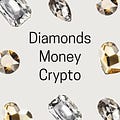What Diamonds, Fiat Money, and Crypto All Have in Common
If you ever want to know the story of diamonds, I recommend, Stoned: Jewelry, Obsession, and How Desire Shapes the World. Among other things, it’s a fun exploration of how the world came to believe that diamonds were rare (they're not) and an absolute must for a wedding.
As the author Aja Raden explains, diamonds were rare up to 1870. Up to that point, diamonds got mined in South Africa, and the ones in the Golcanda region of India were without peers. However, one day a young boy named Erasmus Jacobs pulled a “massive, misshapen crystal out of the Orange River in South Africa.” And at that moment, what was rare became commonplace. You see, diamonds came out from the ground by the metric ton instead of in small lots. Game-changer!
The De Beers Roadmap to the Positional Good of Diamonds
Cecil Rhodes was the founder of the De Beers company. As Raden explains, his idea wasn't just to control the supply of diamonds in its entirety but also the perception of scarcity. That little number was essential for ensuring wealth and riches never imagined. Rhodes limited the supply with perceived lack (there was never any scarcity).
Moreover, through an iterative process that took years, De Beers added positional good to the scarcity of diamonds they created. Positional good means that the desire of others determines the value itself of diamonds. Well, that's a recipe for great success in the case of diamonds and other things (e.g., prime real estate). Positional good means that something is scarce (even if it's not), but more importantly, it's a must-have by others, and in some cases (e.g., master art), 'everyone’ can’t own it—it can only be a select few.
As the story continues, by the 1930s, De Beers controlled the world's diamond supply. However, on the eve of the Second World War, and as a result of the Depression, those who had diamonds weren’t buying them—they were trying to sell them. (Side note: You could never resell a diamond because it would destroy demand, and that’s why if you’ve ever tried, you’ll get nothing for it).
Ultimately, De Beers decided to continue manipulating supply and demand by linking the diamond with love—especially for the American market with soldiers heading home from World War II. In 1947, New York advertiser, N.W. Ayer created the iconic tagline, 'A diamond is forever.' Eventually, advertisers started the idea that if you wanted to make a proper marriage proposal, it required a diamond, and the rest is history.
As the World is Moves Away from Fiat Money
As we know, the world shifted massively—or was shoved—into the digital era. Recently, I caught the words of Eswar Prasad, an economist at Cornell University, “We are at an interesting juncture. It is a period of a great degree of concern about what happens to traditional forms of money and whether these technological developments we see around us are going to benefit us in some way or just create more disruption and turmoil.”
The reality is that it’s true that we’re moving away, and quickly, from how we used fiat money (declared as legal tender by governments). Personally, I rarely touch cash and coins. First, it’s dirty (and who needs more reasons to create any opportunities to get sick? The seasonal flu twined with COVID's doing a great job in and of themselves). Second, governments, banking, and commerce across Europe and the United States have shifted from money and coins.
However, in the same piece mentioning Prasad, journalist Peter Coy said the concern among economists and world leaders is the issue of global trust in fiat money. In other words, will people still believe there's any value to non-digital money going into the future? Not believing it, of course, would set in motion a destabilizing chain of events. In short, the money from our credit cards, debit cards, and mobile devices isn't backed by governments as in the past. They get issued by banks and corporations such as MasterCard, VISA, or American Express. That money, as Coy aptly said, is inherently different than digital money, and "…a virtual dollar in a checking account at your bank is fundamentally different from a dollar bill or four quarters in your fist.”
Digital Money and the Digital Universe
It doesn't take a genius to understand that the world's essentially changed, and we're genuinely emerging into the digital era. For one, the idea of the metaverse (not necessarily Meta's version) is a fascinating one. Imagine being in one city and having a coffee with friends in the digital metaverse world in real-time.
I find it incredible to think that I could, in my lifetime, have a conversation with the digital versions of the best writers and artists in history. That dinner conversation idea of going around the table and saying the three people living or dead that you’d like to speak to if you were stuck on a desert island is a reality that’s already in the making.
But, the very idea of the positional good related to money is changing in an era of enormous disruptive change. If you think of crypto, it seems like it's all many people could speak about through 2021. So many people want to own and buy crypto, which will only increase. It's not government-backed. Its entire architecture is inherently different than fiat money. So, the value of something you can't touch or ever truly possess, like a diamond, cash, or even gold bars, is whatever enough humans to find of value.
So, what do diamonds, fiat money, and now crypto, and NFTs, etc., have in common? They're an illusion, and their perceived value is what we make of it. Where is all of it going to go? I don’t know, but we all need to buckle up because it’s going to be a wild ride.
© 2021 My Red Sneakers. All Rights Reserved.


